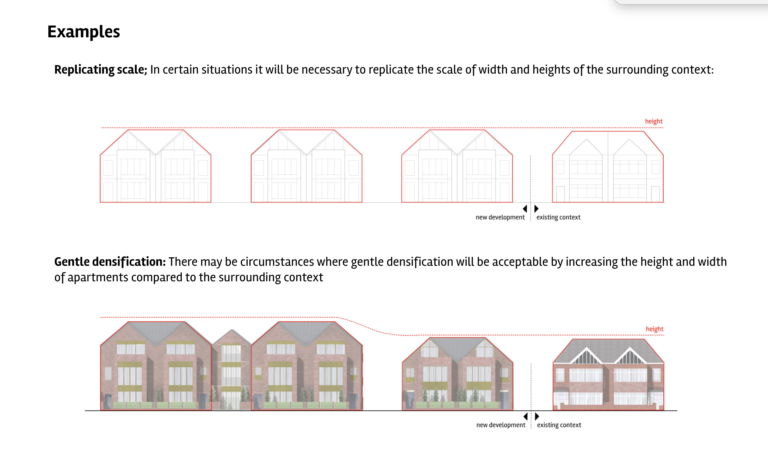Emergence of Design Codes
It is significant to understand why Design Codes have been required before arguing about them. The emergence of Design Codes is not accidental, but to a large extent almost inevitable, as it essentially ensures a well-designed minimum requirement that residents are supposed to appreciate.
Why is Design code important?
In fact, an unclear planning system may cause doubts in the public mind about the credibility of the planning authority, and as Victoria Hills, Chief Executive of the RTPI, described ‘public confidence in the planning system in England is at an all-time low’ (as cited by Flatman, 2023). This is because unclear planning requirements could result in increased investment costs for housebuilders and public dissatisfaction with the mediocrity of new builds, as Senior Architectural designer Kwolek (2023) describes due to the fact that most housebuilders find it difficult to provide an effective programme that guarantees well-design. Therefore, a design code is necessary to ensure to a large extent the quality of the building and to provide a unique identity to the building.
How does a design code affect a design?
Additionally, it is a way of regulating areas that share some of the same characteristics, and the code establishes the most accurate and specific guidance possible for the different areas. As one of the authors of the National Model Design Code, Rudlin (2023) claimed that the Design Code could accurately show what was permitted, as well as various individual dimensional requirements such as building height and area, as can be seen in Fig. 1.
Fig. 1 – Example from the NMDC of a street compliance diagram showing how much of the frontage should be occupied by development (Ministry of Housing, Communities and Local Government, 2021).
It largely responds to researcher Payne’s (2023) highlight that design code differs from design guidelines in that the design code is a more objective ‘binary decision making’, unlike design guidelines which are just a vague concept. Consequently, some architects such as Phil Doyle, Director of 5plus Architects have suggested that an overarching design code would be difficult to satisfy a diverse range of local characteristics (as cited by Whelan, 2021).
Significance of Local Design Codes
Indeed, local design codes cannot be ignored as the situation faced by each region is different. For example, the Trafford Design Code, which creates a long-term, locally-adapted design code based on the overall national design code and incorporating local context, history and cultural characteristics, divides the design code into different functions, as illustrated in Fig. 2.
Fig. 2 – Trafford’s design codes are based on different functions (Trafford Council, 2023).
As a result, Trafford provides an effective design code to ensure the quality of new projects to communities, developers and landowners, for example, when designing an apartment, Trafford’s design code makes it clear that it requires consideration of the scale and context of the surroundings, reference to existing architectural features and roof forms and ensuring that amenity spaces and windows have satisfactory natural light levels, as can be seen in Fig. 3.

Fig. 3 – Trafford’s design codes for Apartments (Trafford Council, 2023).
This kind of clear design code could largely reduce the cost of investment for housebuilders and increase investor confidence. However, it seems that architects in the UK are sceptical about design codes, which they believe could be a constraint on design and lead to uniformity in building form. As Ewen Miller, director of Calderpierre Construction, points out “It is a sad reflection that we feel the need to do this. Some great architecture has been produced without such documents. My concern is that it all descends into a one-size-fits-all blandness” (as cited by Whelan,2021). However, in fact, local and national design codes may not completely restrict designers’ creativity, as government architect Sarah Allan highlights the government’s efforts to collate these codes into a toolkit of ‘simple, concise, illustrated design requirements’, the parameters of which could be adapted by local planning authorities to specific local contexts (as cited by Spocchia, 2023). Furthermore, expensive and individualised designs are not affordable to all, as Loftus (2023) highlights design code should be used to address the housing crunch and climate change issues that society is currently facing.
Conclusion
Overall, the Design code provides detailed requirements and guidelines for the development of a site, while some architects consider that it restricts creativity to a certain extent, the design code ensures that more people have access to high-quality liveable space.
List of Figures
Fig. 1 – Example from the NMDC of a street compliance diagram showing how much of the frontage should be occupied by development. Take from: Ministry of Housing, Communities and Local Government (2021). National Model Design Code Part 1 The Coding Process. London: Crown copyright.
Fig. 2 – Trafford’s design codes based on different functions. Take from: Trafford Council (2023), Trafford Design Code. Available at: https://trafforddesigncode.uk/.
Fig. 3 – Trafford’s design codes for Apartments. Take from: Trafford Council (2023), Trafford Design Code. Available at: https://trafforddesigncode.uk/apartments/form-and-profile/.
List of References
Flatman, B. (2023). Will design codes help unlock the planning system? Online: Building Design. Available at: https://www.bdonline.co.uk/briefing/will-design-codes-help-unlock-the-planning-system/5123186.article.
Kwolek, R. (2023). Design codes: What they are and how to create them. Online: Building Design. Available at: https://www.bdonline.co.uk/opinion/design-codes-what-they-are-and-how-to-create-them/5123499.article.
Loftus, H. (2023). Architects should get involved with design codes – before it’s too late. Architects’ Journal: online. Available at: https://www.architectsjournal.co.uk/news/opinion/architects-should-get-involved-with-design-codes-before-its-too-late.
Ministry of Housing, Communities and Local Government (2021). National Model Design Code Part 1 The Coding Process. London: Crown copyright.
Payne, V. (2023). Design codes – an update. Online: Royal Town Planning Institute. Available at: https://www.rtpi.org.uk/blog/2023/april/vicky-payne-design-codes-an-update/.
Rudlin, D. (2023). What will design codes in local plans mean for you? Online: The RIBA Journal. Available at: https://www.ribaj.com/intelligence/national-model-design-code-local-authority-plan.
Spocchia, G. (2023). Design codes not a straitjacket, says government architect. Architects’ Journal: online. Available at: https://www.architectsjournal.co.uk/news/design-codes-not-a-straitjacket-says-government-architect.


